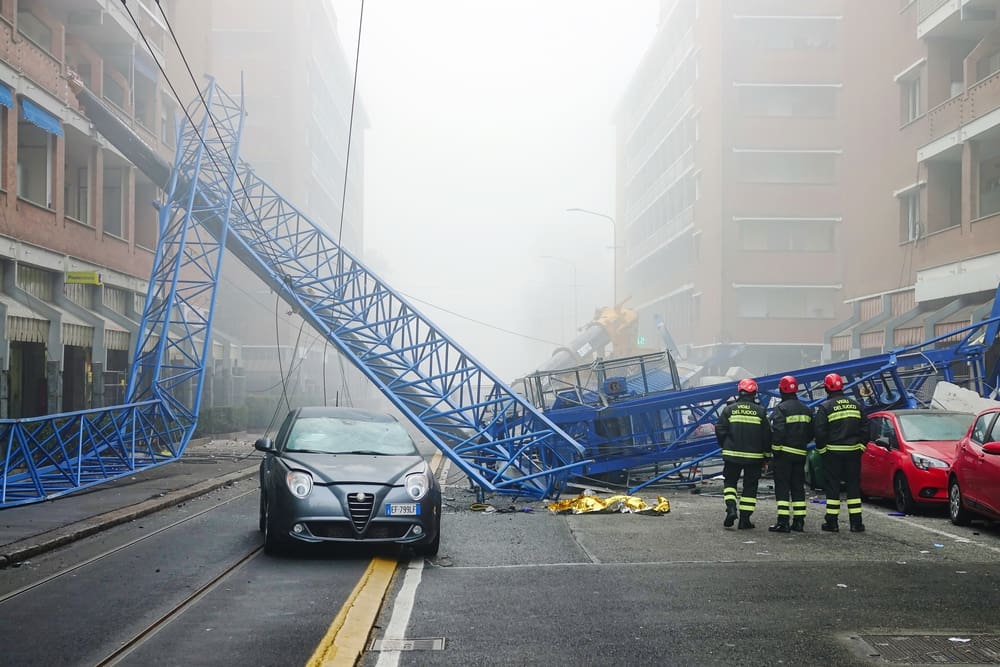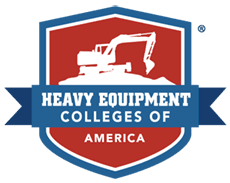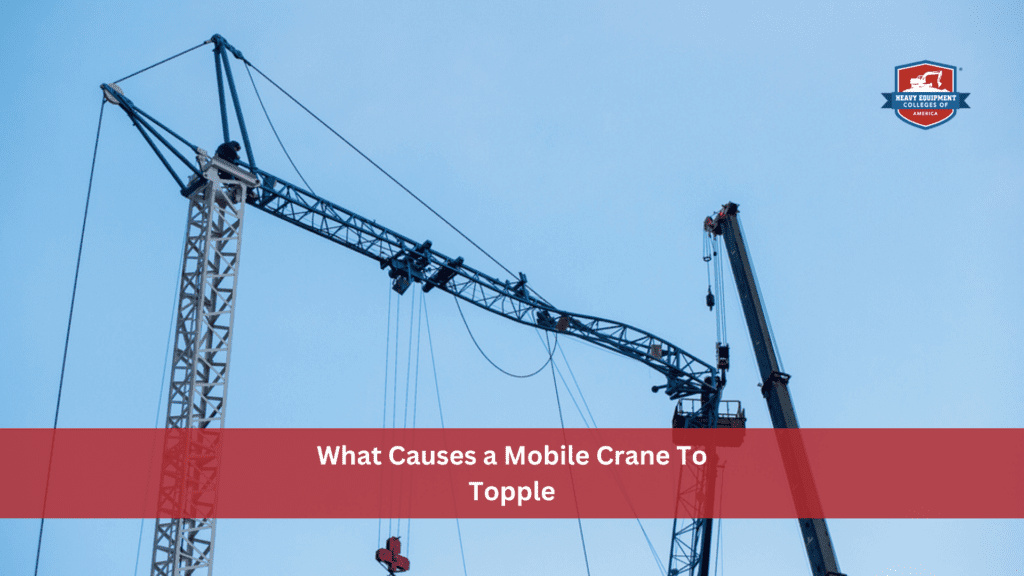Table of Contents
The construction industry plays a vital role in our societal infrastructures and keeping them sturdy and secure. Cranes are often used in these construction sites to move heavy materials and lift supplies to wherever they are needed on the job site. While construction sites have an inherent risk due to the nature of the work involved, numerous cranes overturn or fall over on construction sites each year, causing serious accidents. From personal injuries to property damage, a toppling crane is a serious concern that needs to be addressed properly.
What causes a crane to fall over unexpectedly? In this discussion, we will go over how cranes are built to stand up on their own, common causes for a crane to topple over, and what you can do to prevent these incidents from happening.

How Do Cranes Stay Up in the First Place?
Mobile cranes are fascinating pieces of heavy machinery that are impressive in stature. They are designed to reach high places and transfer heavy loads wherever they are needed on a construction site. How do they stay up in the first place without falling over? One of a mobile crane’s main threats is torque, or the force applied to an object that can shift its center of gravity.
Torque is one of the main causes of a crane falling over, which is why cranes are built to counter it. This includes designing cranes with a longer boom and a wider base to prevent toppling over. Many cranes are also equipped with counterweights to offset this torque and keep the crane balanced as it moves materials around.
How Cranes Can Topple
While mobile cranes are designed to be structurally sound and safe for workers to use, no piece of heavy equipment is immune to faulty parts or unsafe weather conditions. This is not meant to instill fear in readers or bash mobile crane manufacturers, it is simply to bring awareness to these risks so you can do what you can to keep yourself safe when working around large mobile cranes. Knowing the risks can give you insight into how to prevent a mobile crane accident.
There are a handful of reasons that could cause a mobile crane to collapse, and 9 of the most common reasons include the following.
1. Overloading: Cranes have a weight limit on how much they can safely lift and transfer. Intentionally going above these weight limits puts you at a serious risk of the crane falling over and causing an accident. Too much weight can change the crane’s center of mass and lead to increased stress and torque on the crane parts that may not be able to handle it. This can cause parts to break or the crane to become unbalanced and fall over.
2. Improper Stabilization: Cranes need to be properly stabilized with the right equipment as well as sturdy ground underneath them. Without the proper stabilization, the crane is at a higher risk of falling over and causing serious injuries.
3. Incorrect Terrain: Various styles of cranes can handle different terrains such as pavement or dirt roads. If you use the wrong type of crane for the environment you are working in, this can cause the base of the crane to become wobbly and unstable. An unstable base creates an increased risk of the crane falling over, so it is important to set yourself up for success with a strong base.
4. Wind: Various weather conditions can make operating a crane more risky. The crucial weather pattern to keep an eye on when operating a crane is the wind patterns. Strong and direct winds can push against the crane and cause it to start leaning, placing more stress on the various crane parts.
5. Faulty Equipment: Whether a screw was missing or a support brace was improperly manufactured, any faults with the equipment itself can increase the risk of a crane toppling over. Cranes must follow certain manufacturing regulations to keep them working properly and safely.
6. Failing Parts: As equipment gets older, it begins to wear down due to routine use and certain weather patterns. With enough wear and tear, parts of the crane can begin to fail and lead to crane falls. This is why it is important to stay on top of routine maintenance and inspections on your equipment to check for any failing parts that may need replacements.
7. Improper Assembly Or Disassembly: Cranes can be assembled and disassembled on-site for ease of transportation. If the proper procedures are not followed and the crane is assembled incorrectly, this can compromise the crane’s structural integrity and increase the risk of it falling over.
8. Vertical Deformation Of The Ground: The slope and shape of the ground can make or break the stability of a crane. It is crucial to position the crane on flat ground rather than areas with steep slopes or inclines. Ground with steep vertical deformations can make the crane wobbly and increase the risk of it toppling over.
9. Water Affecting Bearing Capacity: The weight that a crane can safely carry depends not only on the equipment itself but also on the ground beneath it. If the soil is especially wet from a lot of recent rainfall, this can cause the crane to sink in and become uneven and wobbly. It is important to check the status of the soil beneath a crane to make sure that it is stable enough to withstand the weight of the crane and its loads.
How long is the Mobile Crane Certification Training at Heavy Equipment Colleges of America?
How to Avoid Tip-Overs in Mobile Cranes
- Use the Correct Type of Mobile Crane: There are different cranes designed for different circumstances, and it is important to choose the right crane for the job at hand.
- Set Up Proper Stabilization Before Use: Follow the proper procedures to make sure the crane is stabilized properly before you use it. This can include things such as extending the outrigger beams.
- Utilize Load Indicator Systems: Load indicator systems can help determine the weight limits of your crane and whether or not it would be safe to use in a specific circumstance.
Become A Certified Crane Operator
Interested in becoming a certified crane operator? The Heavy Equipment Colleges of America (HEC) has a crane operator training school that will give you the skills and knowledge necessary to pursue your crane operator certification. Our campuses are located in Georgia, Oklahoma, California, and Washington state.
If you have any questions about our mobile crane operator training program, the admissions process, or any other concerns, visit our website or get in touch with us! We are more than happy to help you every step of the way as you pursue your crane certification!
Start Your Crane Operator Career With Confidence
Kickstart Your Crane Operator Journey Today!
Hands-On Training | OSHA-Compliant Courses | Job-Ready Skills
Become a Certified Tower Crane Operator Today!
Start Enrollment ProcessFind The Right Location For You
